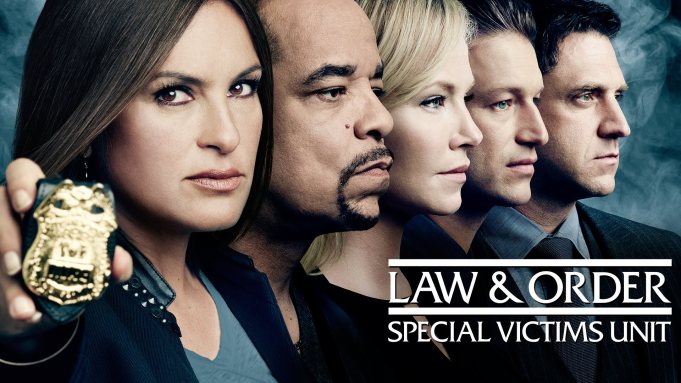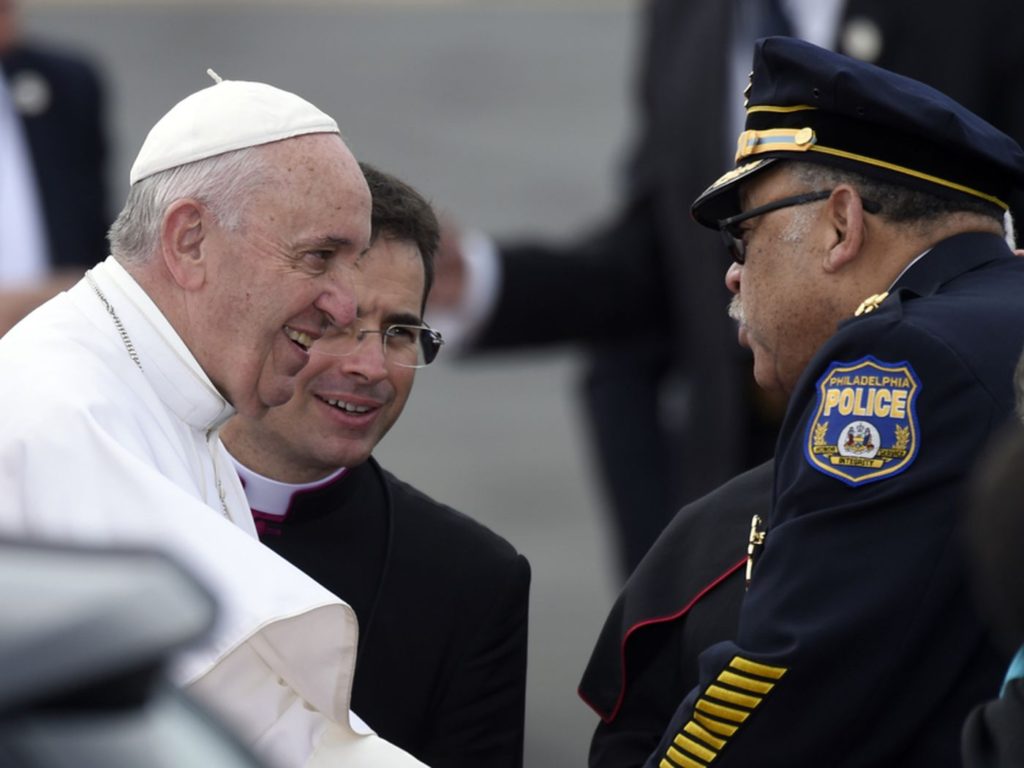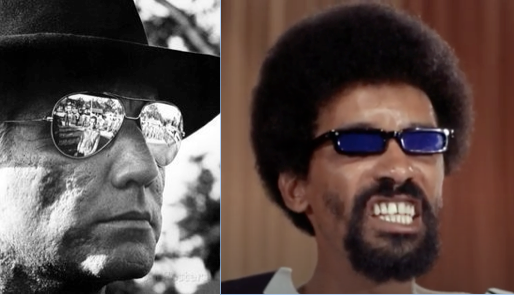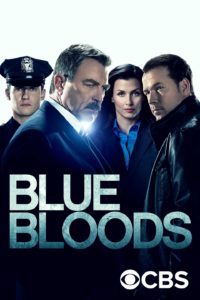Cops and Clergy on TV: Catholicism and the Police Procedural Drama
TV shows about police have relied on Catholicism to portray cops as sacred to America's wellbeing, a long-lasting trend despite protests against the police

(Poster for Law & Order: SVU, one of the longest-running prime-time shows on television)
Even after the video circulated of George Floyd’s brutal murder on May 25, 2020, and the ensuing months of protests organized by the Movement for Black Lives, television shows that celebrate police have persisted in popularity. Although police procedural dramas have received critical attention for propping up the ideological foundation of police violence and mass incarceration, they have staying power. Over the past ten years, as many as 29% of all scripted dramas have been crime shows. Two of the longest-running series on the air (NCIS and Law and Order: SVU) are police procedurals, as were seven of the fifteen most watched dramas on television from 2019-2020.
Viewers of crime dramas, according to a recent study, are confident the criminal justice system works well and tend to support the death penalty, both views that correlate with political conservativism. This confidence is reinforced by the soothing routine of the police procedural. In the words of Guardian critic David Stubbs, “the detectives may trudge somberly from one improbable homicide scene to another, week in, week out, as the blue lights circle bleakly, but we, the viewers, sink gleefully into our sofas ready to drink it in like cocoa. It’s a parlour game, a ritual.”
By describing such shows as a “ritual,” what can we learn about the representation of law enforcement in popular media?
This question is important because police procedurals developed an abiding apologetics for the police by relying on Christian rhetoric. In turn, this apologetics shifted from television studio to the streets. The tropes of duty and self-sacrifice constantly churned out by The Police Tribunal, the national online news site of Blue Lives Matter, began in the writers’ rooms of police shows as far back as the 1950s. In developing that rhetoric, police procedurals adapted the Christian, and particularly Catholic, significance of duty and self-sacrifice from the vocation of the priesthood. To understand television’s enduring ideological support for law enforcement we need to scrutinize these religious undercurrents.
Paying attention to the police procedural’s use of priestly characteristics in the depiction of law enforcement enables us to better understand how this television genre has rendered the police as morally righteous, indispensable, and as a source of salvation for American society. These television dramas have centered the police in the country’s national mythology, which has made criticism and reform of law enforcement all the more difficult.
Rhetoric of sacred self-sacrifice appears not only in television shows about the police; it features heavily in patriotic narratives of fallen soldiers and in narratives of domestic policing in the wake of 9/11. The official Blue Lives Matter Facebook group dedicates itself to “the warriors who stand on this line, to those who wage war in the streets, to those we have lost and will lose.” This sense of inevitable self-sacrifice contributes to the pervasive notion that the police, like priests, are separate from the rest of society but also uniquely responsible for its salvation.

(Photo Source: Susan Walsh for the Associated Press)
Dragnet, the show that Law and Order producer Dick Wolf referred to as “the father of us all,” created strong associations between the police and the priesthood. The show began on the radio in 1949 and moved to television in the 1950s. Jack Webb, the show’s creator, producer, and star, developed a close working relationship with Chief William Parker of the Los Angeles Police Department, an early adopter of “the thin blue line” image which symbolizes the police’s essential role in society. Webb described the show as “entertainment with an ulterior motive” and agreed that Parker would have oversight over all the Dragnet scripts. The LAPD’s reputation was tarnished around the same time by the 1951 “Bloody Christmas” police riot as well as consistent complaints of racial bias. Webb, who was an experienced actor on hardboiled noir radio shows, applied the stripped-down, masculinist style of that genre to defend law enforcement. A key feature of the show was its attempts at realism, utilizing extensive technical input from LAPD experts. Webb cultivated the impression of verisimilitude, taking a “ripped-from-the-police-files” approach, and began each episode with the narrator’s declaration that “the story you are about to see is true. The names have been changed to protect the innocent.” Decades later, one Catholic intellectual praised Webb’s theological valorization of the police, describing the opening formula as “familiar as an oath, comforting as a prayer.”
One way to understand how police procedurals adapt the rhetoric of priestly duty is to examine moments when priests and police appear together in these shows. The presence of the priest in a procedural facilitates comparisons that sacralize law enforcement. This was true in the 1950s, but also recently: in 2015 the executive producer of the CBS series Blue Bloods described the show as an “interweaving of two tribes: cops and church.”
But why has the Catholic priest been so important for police shows in a country that has had its fair share of anti-Catholic prejudice? In police procedurals Catholicism connotes urban white ethnicity, specifically, that of Irish-Americans. Larger urban environments are the settings for many procedurals and there is a longstanding cultural assumption that Irish-Americans work as law enforcement in such cities. This ethnic and religious particularity humanizes the police, giving these primarily white figures greater depth while making them more than simply tools of the state. The association between the police, white ethnicity, and Catholicism also endows the police with a moral vocabulary of duty, self-sacrifice, and hierarchy that helps secure the police a righteous position in both national discourse and city budgets.
Policing as Sacred Duty in Dragnet
Dragnet goes out of its way to show the resemblance between the Catholic priesthood and the LAPD. In an episode from 1953, “The Big Little Jesus,” a crèche baby Jesus statue goes missing from a church on Christmas Eve. The priest who reports the theft remarks to Joe Friday (Jack Webb) that it is unfortunate how “in so short of a time men learn to steal.” Friday speaks to the priest as if they were colleagues: “But consider us, Father.” The priest is confused by the “us.” “If some of them didn’t, you and me would be out of work,” Friday explains. Priests and police exist to counter the sinful impulses of humanity.
As the series progressed, however, it became clear that the police might be outperforming the priests. In the 1969 episode “B.O.D.”, (Dragnet 27) a priest- journalist shadows the detectives as they pull a night shift at the Business Office Division. The priest, Father Barnes (Grant Williams), is consistently amazed at the LAPD’s combination of efficiency and respectful treatment of Los Angeles’s citizens. At the end, Father Barnes can finally do something the detectives can’t, as he rushes off to a hospital to assist in performing last rites for a fatally injured officer. When priests like Barnes appear in Dragnet, they are members of the same spiritual family as the police, yet less equipped to confront the moral problem of the age: modern crime. And yet, Father Barnes’ eagerness to perform last rites suggests a partnership, a shared commitment to making sacrifices for the sake of the community.
Police self-sacrifice in Dragnet frequently serves to justify the use of lethal force. This becomes clear in the season three episode “Public Affairs.” It first aired on September 19, 1968, just months after Martin Luther King Jr.’s assassination, the uprisings in D.C., Chicago, and Baltimore, and the assassination of Robert Kennedy, and merely one month after the authoritarian crackdown on protests at the Chicago Democratic Convention. In this episode, Joe Friday and his partner Bill Gannon appear on a local television show to respond to criticism of law enforcement. Friday argues that the police preserve democracy by “bleeding for it,” all because they believe in law and order and “the idea that people are better than animals,” and loathe “the law of the jungle.” They sacrifice themselves for “the idea that a civilized nation is better than a jungle.”
Friday’s repeated references to the “jungle” take on a distinctly racist connotation as the next member of the audience mounts the podium, the dashiki-clad Mondo Mabamba (Dick Anthony Williams). Mabamba never removes his sunglasses, referencing the demonic Boss Godfrey, “the man with no eyes,” from Cool Hand Luke (1967). If police officers are offering themselves up as sacrifices for the common good, then Mondo Mabamba, as a Black nationalist, stands as their persecutor, accusing the LAPD of being second-rate Nazis. When Mabamba presses the detectives on the LAPD’s cowardly reliance on auto patrols, Friday responds that the department is considering foot patrols in the Black neighborhoods to establish trust. Mabamba sneers at his comrades in the front row, a signal that they will be ready when the beat cops come strolling by. The scene reinforces the implicit argument of the episode: a police officer is justified in taking the lives of dangerous people of color precisely because he is always ready to give his own.

(Left: Boss Godfrey in Cool Hand Luke; Right: Mondo Mabamba in “Public Affairs”)
Protecting the White Family in Contemporary Police Procedurals
Dragnet may have been the “father of them all” when it came to police procedurals, but pop culture representation of the police changed significantly in the ensuing decades as shows attempted to present more psychologically-developed characters struggling through the cultural and political upheavals of the 1960s and 70s. Friday’s lack of a personal life was the sign of his seriousness as a public servant. But following the publication of the 1971 novel The New Centurions by police-officer-turned-writer Joseph Wambaugh, the personal costs of policing became an abiding element in procedural storytelling for shows like Hillstreet Blues in the 1980s, NYPD Blues in the 1990s, and The Wire in the 2000s. In contrast to Dragnet, these series emphasize the pressures that “the job” exerts on the inner lives of complex characters. Police work often appears as tragically sisyphean and isolated in urban environments misgoverned by cynical elites.
Other prominent series continued the Dragnet tradition of deemphasizing the inner lives of their characters while emphasizing their role in investigative and legal procedures, most notably the Law and Order franchise. But there was no going back after the turn to the personal, and most shows fused soap-opera elements with the grind of crime-solving. As audiences were expected to care about the complex psychologies of characters in law enforcement, they were also being primed to identify police work with the military and counter-terrorist operations that followed 9/11. The patriotic rhetoric of self-sacrifice for the homeland began to reach a greater intensity than it ever achieved on Dragnet.
CBS’s Blue Bloods, which has aired since 2010, exemplifies this shift. Tom Selleck, iconic as the star of Magnum P.I., now plays the police chief of the New York Police Department as well as the patriarch of the Reagan family. His two sons, Danny (Donnie Wahlberg) and Jamie (Will Estes), have followed him into the family business, while his daughter Erin (Bridget Moynahan), works as a prosecutor for the district attorney. Danny, an Iraq War veteran with PTSD and a penchant for breaking the rules (and suspects’ faces), reinforces the link between the military and domestic law enforcement. Jamie is the youngest, a rookie beat patrol officer learning the basics after walking away from an elite legal career. Similar to Law and Order, Blue Bloods portrays the criminal justice system at each step, from the street to police headquarters and into the courtroom. But by making the NYPD into a family business, the show blurs the line between the personal interests of these characters and their official duties. The sacrifices they make for their careers, their family, and the public order become indistinguishable.
 Blue Bloods plays up the Reagans’ Irish-Catholic roots, but we rarely see them in church. The ritual most important to the show is the weekly Sunday dinner during which the main themes of the episode are hashed over and usually resolved through Francis’ paternal guidance. By portraying Chief Francis as “more Catholic than the pope,” the show gives him a moral integrity that not only outstrips traditional religious leaders but also authorizes extra-judicial acts of violence.
Blue Bloods plays up the Reagans’ Irish-Catholic roots, but we rarely see them in church. The ritual most important to the show is the weekly Sunday dinner during which the main themes of the episode are hashed over and usually resolved through Francis’ paternal guidance. By portraying Chief Francis as “more Catholic than the pope,” the show gives him a moral integrity that not only outstrips traditional religious leaders but also authorizes extra-judicial acts of violence.
The Reagans are not bound by the law, but have instead a deeper calling—defending the American family. In the contemporary police procedural there is a preoccupation with showing the police deeply sympathizing with the victims or, as the shows often call them, “vics.” This emotional connection fuels the detectives’ righteous pursuit of justice. The “vics” are mostly sympathetic characters with families depending on them. But who are the victims in these shows? Of the 26 police procedurals analyzed in Color of Change‘s “Normalizing Injustice” report, “the likelihood that primary crime victims were white men was 35%, white women 28%, men of color 22% (Black men 12%) and women of color 13%.” But in Blue Bloods, 78% of the victims were white, and 71% were male. While television’s most popular police dramas portray whites as the primary victims of crime, the Bureau of Justice Statistics reports that whites account for only 37% of the victims of violent crimes. Further, in Blue Bloods, Reagan family members and their acquaintances frequently appear as targets of violence. This connection shows the viewer whom the police ought to serve and protect—themselves, and by extension, other “real Americans.” The Reagans embody a fantasy of the victimized white-American family that is strong enough to strike back.
The theme of the vulnerable white police family received its most compelling treatment yet in HBO’s 2021 mini-series, The Mare of Easttown. The protagonist, detective Mare Sheehan (Kate Winslet), lives and works in a suburb of Philadelphia hard-hit by the opioid crisis. Mare is traumatized by the suicides of close family members and haunted by the disappearance of young white women in her community. To close these cases, Mare consistently breaks from protocol and takes costly risks. And the costs are real: her relationship with friends and family and even the life of her coworker. The series excels at showing the viewer how much pain Mare has experienced—and how much she causes for the people in her life. But in the end she solves the mysteries and begins to heal, not only on her own, but along with the whole community.
Mare of Easttown’s final episode is titled “Sacrament,” suggesting the sacrament of reconciliation, and features another embattled character, Deacon Mark Burton (James McArdle). Cleared of murder charges, the deacon delivers a homily to a packed chapel in one of the series’ final scenes. Deacon Mark links his own rehabilitation in the community with a spiritual resurgence in Easttown, and invites the parishioners to reconcile with those who have been pushed “outside the circle.” Deacon Mark’s redemption parallels Mare’s. Previously she was the public face of the police’s inability to protect the young women of Easttown. But now Mare’s investigative competence and authentic connection to the people of her community have vindicated the police and given Deacon Mark another chance to minister to the parish. Even in this talent-packed, emotionally complex series, the partnership between the police and the priesthood as stewards and redeemers of a predominantly white community continues unabated.
The Police Procedural after Summer 2020
To open the fall 2020 television season, police procedurals aired season premiers that attempted to metabolize the protests of summer 2020 and address the debate about defunding the police. Blue Bloods responded defensively, portraying backlash against the police as a new opportunity for cynical criminals to get away with more. Black proponents of racial justice appear on the show as either unreasonably bitter or naive, oblivious to the unintended consequences of reforms to cash bail, such as the demoralization of the NYPD and the prospect of everyday New Yorkers being menaced by “criminals” unleashed on the streets. This echoes an established Republican talking point that has no basis in fact.
This context also affected the priestly dimension of the fictional police. The premiere of the twenty-second season of Law and Order: Special Victims Unit, “Gladiators and Guardians,” is similar to Blue Blood’s opener in that it pushes the paranoid argument that the 2020 protests were a boon to criminals. It presents the public backlash against police violence as the trigger for sweeping “witch hunt” purges that could divide the NYPD. But it also triangulates, showing the detectives reflecting on their own susceptibility to unconscious racial bias. Captain Olivia Benson (Mariska Hargitay) understands herself to be “biased for the victims” without realizing the impact of unconscious racial bias on her investigations. She requires the counseling of multiple Black officers and an unjustly treated Black civilian to grasp that she is not as “color blind” as she assumed. Here, Black police officers perform a clerical role for white officers: listening to confessions of racial bias and then expiating guilt.
Internal Affairs Captain Renee Curry (Aime Donna Kelly) questions Benson about her thought-process in the arrest of Jayvon Brown (Blake Morris) in an incident loosely based on the Central Park birdwatching incident of May 2020. When Benson denies acting out of racial bias, Curry stops audio-recording their interview and begins to educate Benson on how the well-intentioned “guardians” of public order need to take “a serious self-inventory.” The scene foregrounds Benson’s discomfort and shame. And yet Curry, a Black woman, is not only her inquisitor but a spiritual counselor, pushing Benson to examine herself in order to win back public trust. Later, Benson confesses her sins to Deputy Chief Garland (Demore Barnes), acknowledging that her unconscious racial bias is real and must be addressed. Garland listens patiently and instructs her to be wary of the NYPD’s institutional politics that will sacrifice white police like her in order to achieve better public relations without any concern for real reforms.
In both instances, Black police appear in a shifting clerical wardrobe, serving as inquisitors, confessors, and counselors. These priestly duties fall to Black characters who are now responsible for ministering to white sinners afflicted by unconscious racial bias. And yet the reforms these characters push for are all supposed to take place in the individual psyches of the detectives. Benson says as much when apologizing to Jayvon Brown at the end of the episode: “The NYPD…” She stops to correct herself, “I have a lot of work to do.” The emphasis rests on personal responsibility and self-scrutiny, rather than any structural changes to the criminal justice system.
***
The focus on individual “bad apples” seeks to deflect criticism from the police as an institution. Individual “maverick” detectives are at once the villains responsible for violent police abuse but also the heroes of this genre: think of Clint Eastwood as “Dirty Harry,” Mare Sheehan, or The Wire’s Jimmy McNulty. Police series center these rugged individuals, cloaking them in white-ethnic authenticity or, increasingly, principled Black patriotism.
By making the police-priesthood “colorblind,” police procedurals are merely updating their apologies for the white-supremacist violence of the current system. The figure of the priestly police officer continues to evolve in the television police procedural. But despite widespread criticism of American police departments, these shows still legitimize, heroize, and sacralize law enforcement in the United States.
Klaus Yoder is a historian of Christianity and a podcaster for Seven Heads, Ten Horns: The History of the Devil. He teaches in the Religion Department at Vassar College in Poughkeepsie, NY.